Approaches for Achieving Globalization: A Case Study of Samsung's Entry into the Indian Market
VerifiedAdded on 2023/05/29
|20
|3335
|269
AI Summary
This essay discusses Samsung's entry into the Indian market and the approaches undertaken for achieving globalization. It analyzes the factors responsible for managing globalization and the development of global and international strategies. The essay also discusses the challenges faced by Samsung while operating in India.
Contribute Materials
Your contribution can guide someone’s learning journey. Share your
documents today.
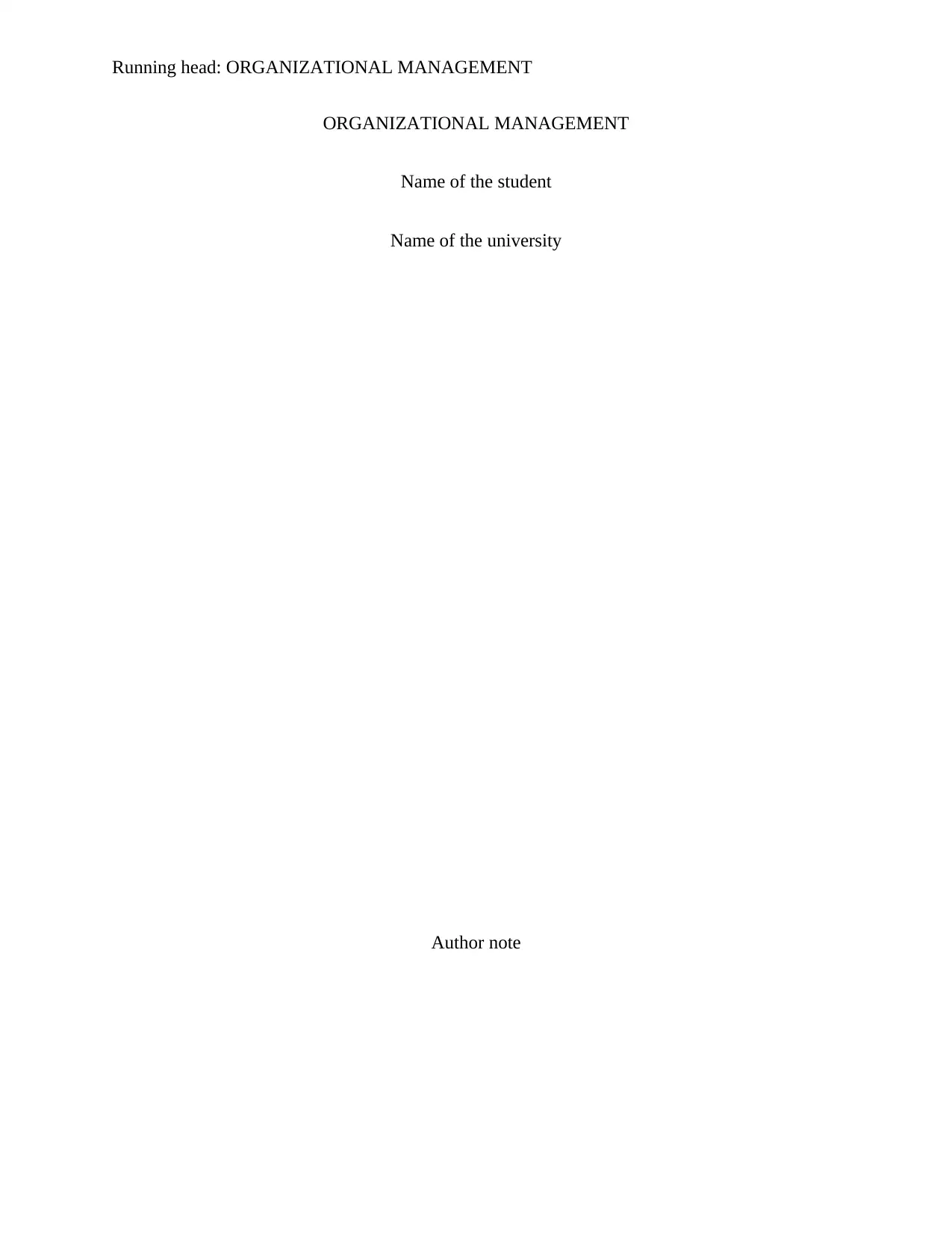
Running head: ORGANIZATIONAL MANAGEMENT
ORGANIZATIONAL MANAGEMENT
Name of the student
Name of the university
Author note
ORGANIZATIONAL MANAGEMENT
Name of the student
Name of the university
Author note
Secure Best Marks with AI Grader
Need help grading? Try our AI Grader for instant feedback on your assignments.
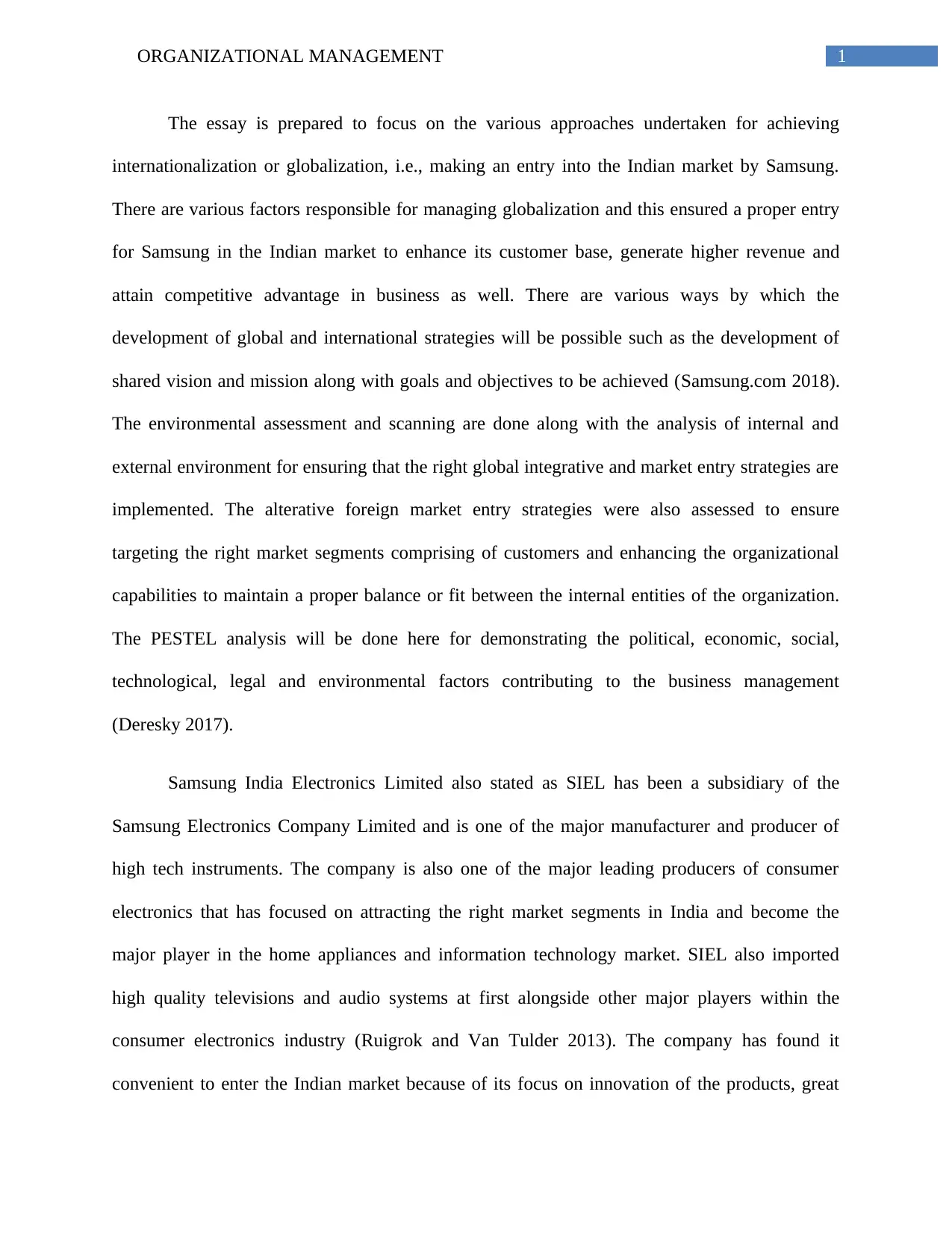
1ORGANIZATIONAL MANAGEMENT
The essay is prepared to focus on the various approaches undertaken for achieving
internationalization or globalization, i.e., making an entry into the Indian market by Samsung.
There are various factors responsible for managing globalization and this ensured a proper entry
for Samsung in the Indian market to enhance its customer base, generate higher revenue and
attain competitive advantage in business as well. There are various ways by which the
development of global and international strategies will be possible such as the development of
shared vision and mission along with goals and objectives to be achieved (Samsung.com 2018).
The environmental assessment and scanning are done along with the analysis of internal and
external environment for ensuring that the right global integrative and market entry strategies are
implemented. The alterative foreign market entry strategies were also assessed to ensure
targeting the right market segments comprising of customers and enhancing the organizational
capabilities to maintain a proper balance or fit between the internal entities of the organization.
The PESTEL analysis will be done here for demonstrating the political, economic, social,
technological, legal and environmental factors contributing to the business management
(Deresky 2017).
Samsung India Electronics Limited also stated as SIEL has been a subsidiary of the
Samsung Electronics Company Limited and is one of the major manufacturer and producer of
high tech instruments. The company is also one of the major leading producers of consumer
electronics that has focused on attracting the right market segments in India and become the
major player in the home appliances and information technology market. SIEL also imported
high quality televisions and audio systems at first alongside other major players within the
consumer electronics industry (Ruigrok and Van Tulder 2013). The company has found it
convenient to enter the Indian market because of its focus on innovation of the products, great
The essay is prepared to focus on the various approaches undertaken for achieving
internationalization or globalization, i.e., making an entry into the Indian market by Samsung.
There are various factors responsible for managing globalization and this ensured a proper entry
for Samsung in the Indian market to enhance its customer base, generate higher revenue and
attain competitive advantage in business as well. There are various ways by which the
development of global and international strategies will be possible such as the development of
shared vision and mission along with goals and objectives to be achieved (Samsung.com 2018).
The environmental assessment and scanning are done along with the analysis of internal and
external environment for ensuring that the right global integrative and market entry strategies are
implemented. The alterative foreign market entry strategies were also assessed to ensure
targeting the right market segments comprising of customers and enhancing the organizational
capabilities to maintain a proper balance or fit between the internal entities of the organization.
The PESTEL analysis will be done here for demonstrating the political, economic, social,
technological, legal and environmental factors contributing to the business management
(Deresky 2017).
Samsung India Electronics Limited also stated as SIEL has been a subsidiary of the
Samsung Electronics Company Limited and is one of the major manufacturer and producer of
high tech instruments. The company is also one of the major leading producers of consumer
electronics that has focused on attracting the right market segments in India and become the
major player in the home appliances and information technology market. SIEL also imported
high quality televisions and audio systems at first alongside other major players within the
consumer electronics industry (Ruigrok and Van Tulder 2013). The company has found it
convenient to enter the Indian market because of its focus on innovation of the products, great
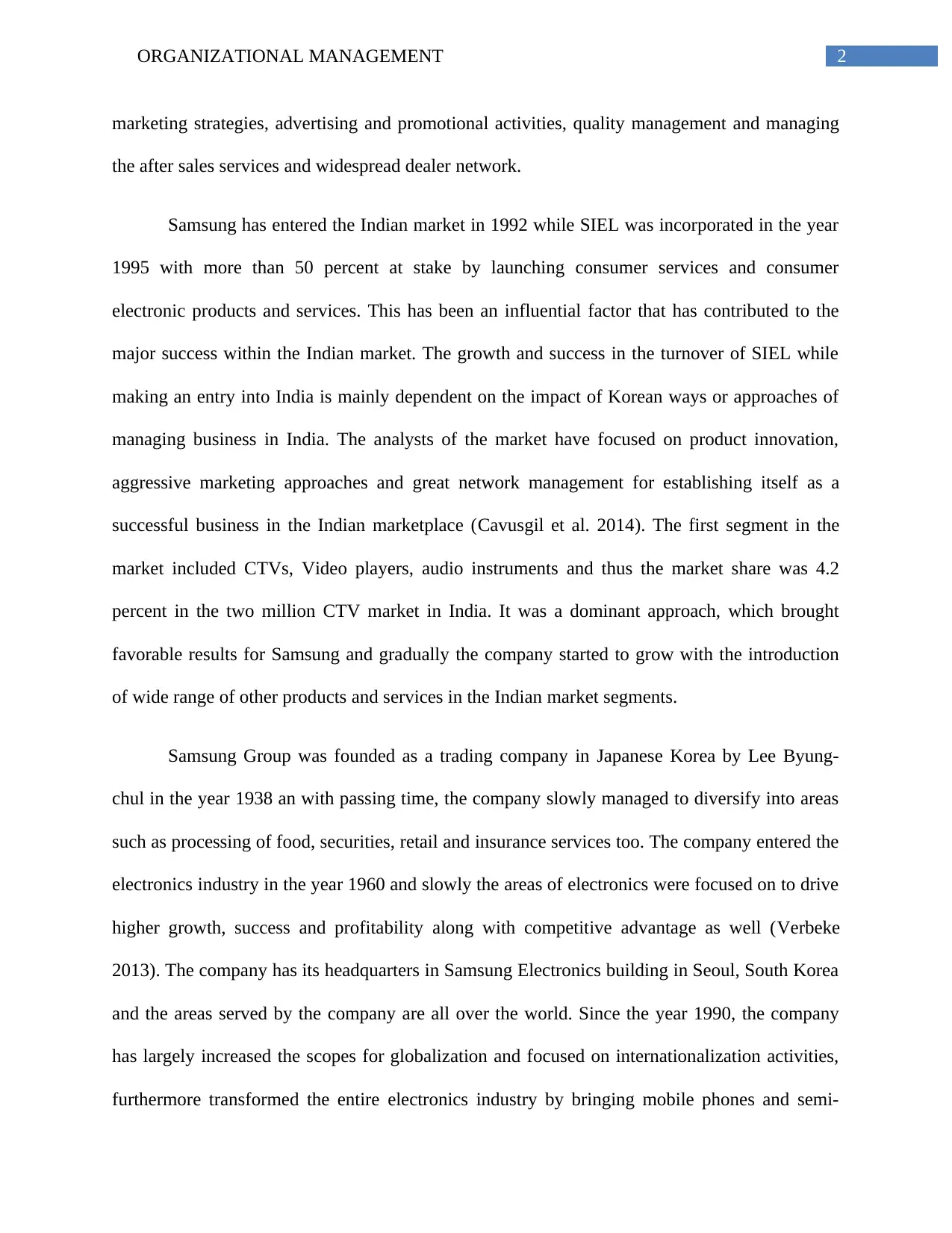
2ORGANIZATIONAL MANAGEMENT
marketing strategies, advertising and promotional activities, quality management and managing
the after sales services and widespread dealer network.
Samsung has entered the Indian market in 1992 while SIEL was incorporated in the year
1995 with more than 50 percent at stake by launching consumer services and consumer
electronic products and services. This has been an influential factor that has contributed to the
major success within the Indian market. The growth and success in the turnover of SIEL while
making an entry into India is mainly dependent on the impact of Korean ways or approaches of
managing business in India. The analysts of the market have focused on product innovation,
aggressive marketing approaches and great network management for establishing itself as a
successful business in the Indian marketplace (Cavusgil et al. 2014). The first segment in the
market included CTVs, Video players, audio instruments and thus the market share was 4.2
percent in the two million CTV market in India. It was a dominant approach, which brought
favorable results for Samsung and gradually the company started to grow with the introduction
of wide range of other products and services in the Indian market segments.
Samsung Group was founded as a trading company in Japanese Korea by Lee Byung-
chul in the year 1938 an with passing time, the company slowly managed to diversify into areas
such as processing of food, securities, retail and insurance services too. The company entered the
electronics industry in the year 1960 and slowly the areas of electronics were focused on to drive
higher growth, success and profitability along with competitive advantage as well (Verbeke
2013). The company has its headquarters in Samsung Electronics building in Seoul, South Korea
and the areas served by the company are all over the world. Since the year 1990, the company
has largely increased the scopes for globalization and focused on internationalization activities,
furthermore transformed the entire electronics industry by bringing mobile phones and semi-
marketing strategies, advertising and promotional activities, quality management and managing
the after sales services and widespread dealer network.
Samsung has entered the Indian market in 1992 while SIEL was incorporated in the year
1995 with more than 50 percent at stake by launching consumer services and consumer
electronic products and services. This has been an influential factor that has contributed to the
major success within the Indian market. The growth and success in the turnover of SIEL while
making an entry into India is mainly dependent on the impact of Korean ways or approaches of
managing business in India. The analysts of the market have focused on product innovation,
aggressive marketing approaches and great network management for establishing itself as a
successful business in the Indian marketplace (Cavusgil et al. 2014). The first segment in the
market included CTVs, Video players, audio instruments and thus the market share was 4.2
percent in the two million CTV market in India. It was a dominant approach, which brought
favorable results for Samsung and gradually the company started to grow with the introduction
of wide range of other products and services in the Indian market segments.
Samsung Group was founded as a trading company in Japanese Korea by Lee Byung-
chul in the year 1938 an with passing time, the company slowly managed to diversify into areas
such as processing of food, securities, retail and insurance services too. The company entered the
electronics industry in the year 1960 and slowly the areas of electronics were focused on to drive
higher growth, success and profitability along with competitive advantage as well (Verbeke
2013). The company has its headquarters in Samsung Electronics building in Seoul, South Korea
and the areas served by the company are all over the world. Since the year 1990, the company
has largely increased the scopes for globalization and focused on internationalization activities,
furthermore transformed the entire electronics industry by bringing mobile phones and semi-
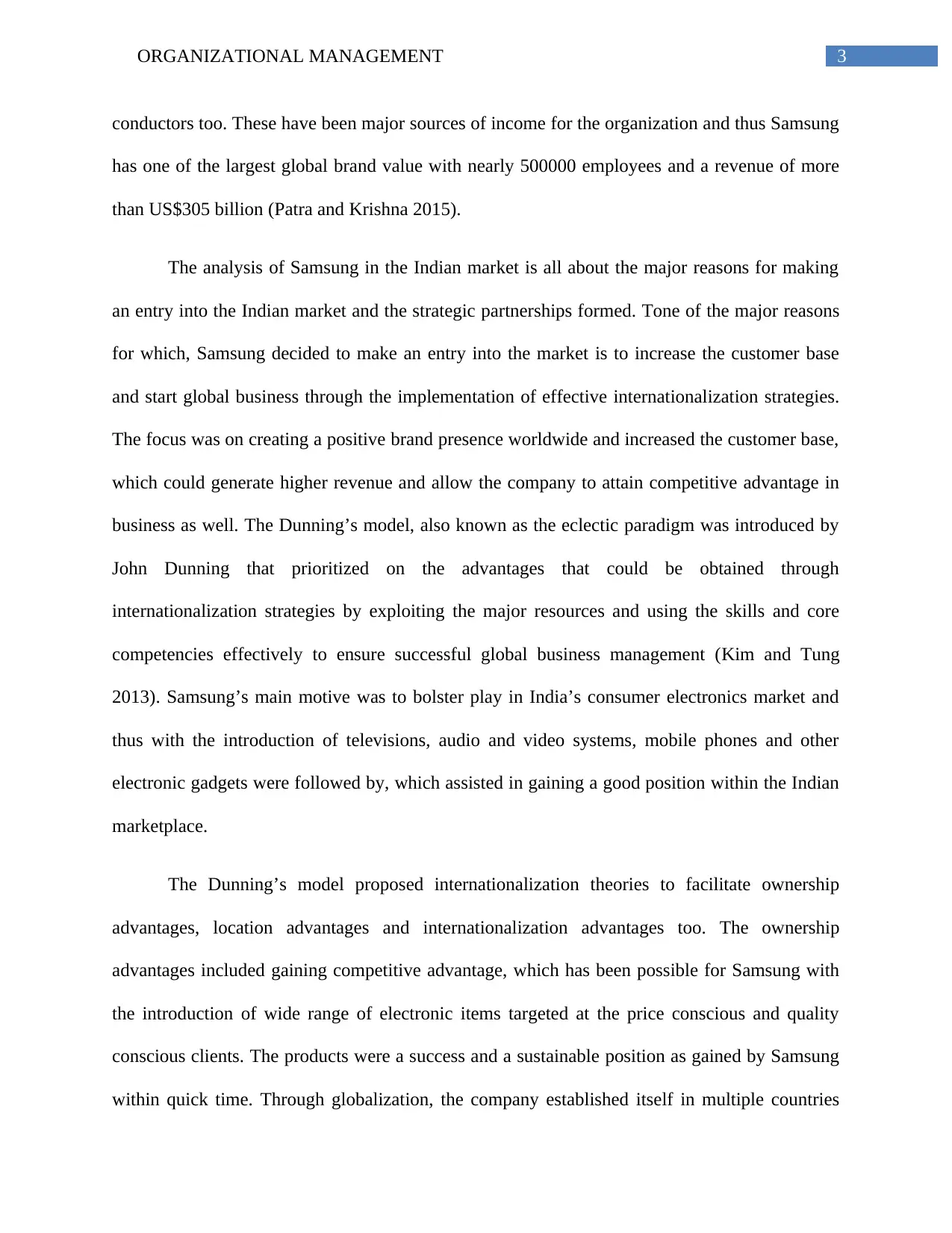
3ORGANIZATIONAL MANAGEMENT
conductors too. These have been major sources of income for the organization and thus Samsung
has one of the largest global brand value with nearly 500000 employees and a revenue of more
than US$305 billion (Patra and Krishna 2015).
The analysis of Samsung in the Indian market is all about the major reasons for making
an entry into the Indian market and the strategic partnerships formed. Tone of the major reasons
for which, Samsung decided to make an entry into the market is to increase the customer base
and start global business through the implementation of effective internationalization strategies.
The focus was on creating a positive brand presence worldwide and increased the customer base,
which could generate higher revenue and allow the company to attain competitive advantage in
business as well. The Dunning’s model, also known as the eclectic paradigm was introduced by
John Dunning that prioritized on the advantages that could be obtained through
internationalization strategies by exploiting the major resources and using the skills and core
competencies effectively to ensure successful global business management (Kim and Tung
2013). Samsung’s main motive was to bolster play in India’s consumer electronics market and
thus with the introduction of televisions, audio and video systems, mobile phones and other
electronic gadgets were followed by, which assisted in gaining a good position within the Indian
marketplace.
The Dunning’s model proposed internationalization theories to facilitate ownership
advantages, location advantages and internationalization advantages too. The ownership
advantages included gaining competitive advantage, which has been possible for Samsung with
the introduction of wide range of electronic items targeted at the price conscious and quality
conscious clients. The products were a success and a sustainable position as gained by Samsung
within quick time. Through globalization, the company established itself in multiple countries
conductors too. These have been major sources of income for the organization and thus Samsung
has one of the largest global brand value with nearly 500000 employees and a revenue of more
than US$305 billion (Patra and Krishna 2015).
The analysis of Samsung in the Indian market is all about the major reasons for making
an entry into the Indian market and the strategic partnerships formed. Tone of the major reasons
for which, Samsung decided to make an entry into the market is to increase the customer base
and start global business through the implementation of effective internationalization strategies.
The focus was on creating a positive brand presence worldwide and increased the customer base,
which could generate higher revenue and allow the company to attain competitive advantage in
business as well. The Dunning’s model, also known as the eclectic paradigm was introduced by
John Dunning that prioritized on the advantages that could be obtained through
internationalization strategies by exploiting the major resources and using the skills and core
competencies effectively to ensure successful global business management (Kim and Tung
2013). Samsung’s main motive was to bolster play in India’s consumer electronics market and
thus with the introduction of televisions, audio and video systems, mobile phones and other
electronic gadgets were followed by, which assisted in gaining a good position within the Indian
marketplace.
The Dunning’s model proposed internationalization theories to facilitate ownership
advantages, location advantages and internationalization advantages too. The ownership
advantages included gaining competitive advantage, which has been possible for Samsung with
the introduction of wide range of electronic items targeted at the price conscious and quality
conscious clients. The products were a success and a sustainable position as gained by Samsung
within quick time. Through globalization, the company established itself in multiple countries
Secure Best Marks with AI Grader
Need help grading? Try our AI Grader for instant feedback on your assignments.
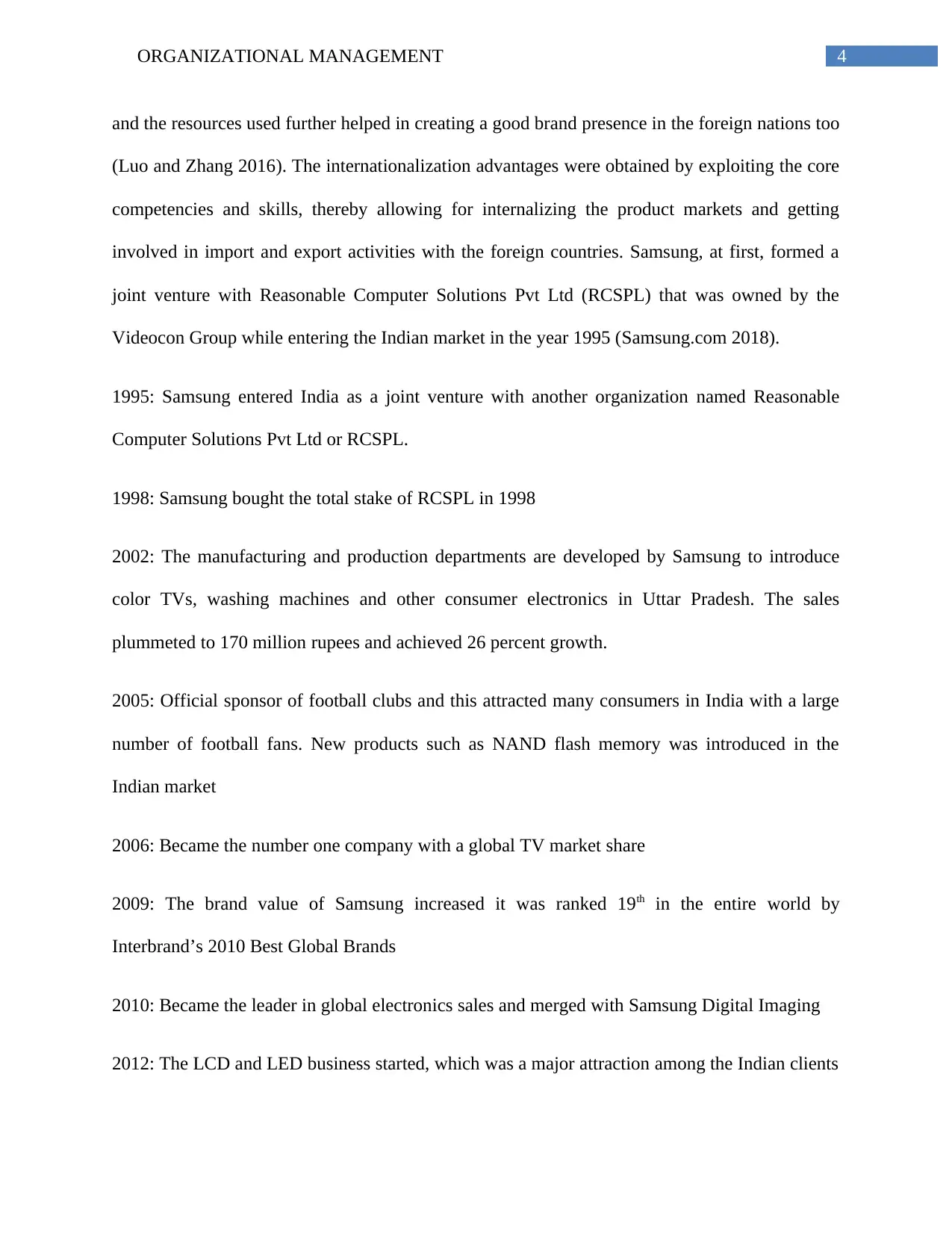
4ORGANIZATIONAL MANAGEMENT
and the resources used further helped in creating a good brand presence in the foreign nations too
(Luo and Zhang 2016). The internationalization advantages were obtained by exploiting the core
competencies and skills, thereby allowing for internalizing the product markets and getting
involved in import and export activities with the foreign countries. Samsung, at first, formed a
joint venture with Reasonable Computer Solutions Pvt Ltd (RCSPL) that was owned by the
Videocon Group while entering the Indian market in the year 1995 (Samsung.com 2018).
1995: Samsung entered India as a joint venture with another organization named Reasonable
Computer Solutions Pvt Ltd or RCSPL.
1998: Samsung bought the total stake of RCSPL in 1998
2002: The manufacturing and production departments are developed by Samsung to introduce
color TVs, washing machines and other consumer electronics in Uttar Pradesh. The sales
plummeted to 170 million rupees and achieved 26 percent growth.
2005: Official sponsor of football clubs and this attracted many consumers in India with a large
number of football fans. New products such as NAND flash memory was introduced in the
Indian market
2006: Became the number one company with a global TV market share
2009: The brand value of Samsung increased it was ranked 19th in the entire world by
Interbrand’s 2010 Best Global Brands
2010: Became the leader in global electronics sales and merged with Samsung Digital Imaging
2012: The LCD and LED business started, which was a major attraction among the Indian clients
and the resources used further helped in creating a good brand presence in the foreign nations too
(Luo and Zhang 2016). The internationalization advantages were obtained by exploiting the core
competencies and skills, thereby allowing for internalizing the product markets and getting
involved in import and export activities with the foreign countries. Samsung, at first, formed a
joint venture with Reasonable Computer Solutions Pvt Ltd (RCSPL) that was owned by the
Videocon Group while entering the Indian market in the year 1995 (Samsung.com 2018).
1995: Samsung entered India as a joint venture with another organization named Reasonable
Computer Solutions Pvt Ltd or RCSPL.
1998: Samsung bought the total stake of RCSPL in 1998
2002: The manufacturing and production departments are developed by Samsung to introduce
color TVs, washing machines and other consumer electronics in Uttar Pradesh. The sales
plummeted to 170 million rupees and achieved 26 percent growth.
2005: Official sponsor of football clubs and this attracted many consumers in India with a large
number of football fans. New products such as NAND flash memory was introduced in the
Indian market
2006: Became the number one company with a global TV market share
2009: The brand value of Samsung increased it was ranked 19th in the entire world by
Interbrand’s 2010 Best Global Brands
2010: Became the leader in global electronics sales and merged with Samsung Digital Imaging
2012: The LCD and LED business started, which was a major attraction among the Indian clients
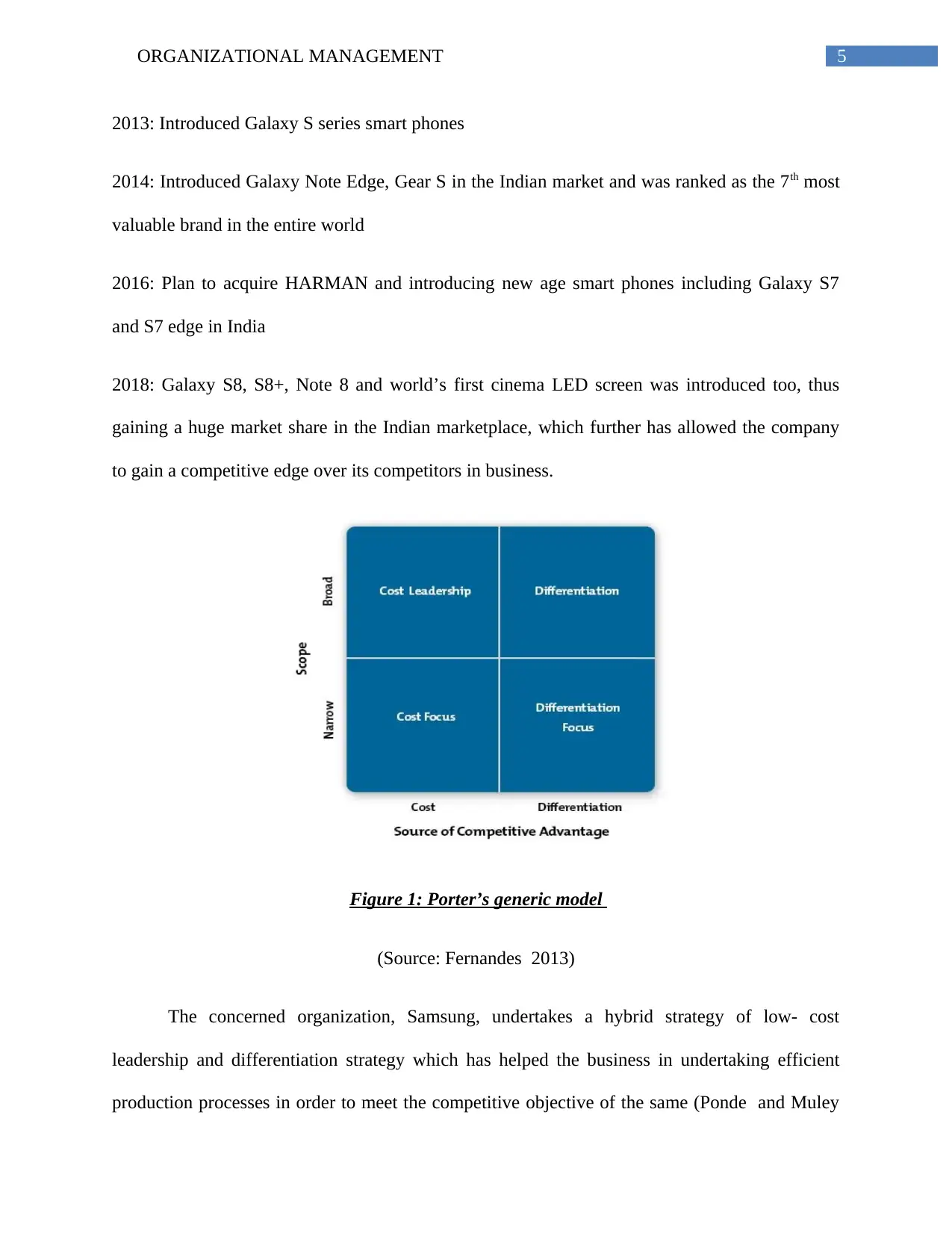
5ORGANIZATIONAL MANAGEMENT
2013: Introduced Galaxy S series smart phones
2014: Introduced Galaxy Note Edge, Gear S in the Indian market and was ranked as the 7th most
valuable brand in the entire world
2016: Plan to acquire HARMAN and introducing new age smart phones including Galaxy S7
and S7 edge in India
2018: Galaxy S8, S8+, Note 8 and world’s first cinema LED screen was introduced too, thus
gaining a huge market share in the Indian marketplace, which further has allowed the company
to gain a competitive edge over its competitors in business.
Figure 1: Porter’s generic model
(Source: Fernandes 2013)
The concerned organization, Samsung, undertakes a hybrid strategy of low- cost
leadership and differentiation strategy which has helped the business in undertaking efficient
production processes in order to meet the competitive objective of the same (Ponde and Muley
2013: Introduced Galaxy S series smart phones
2014: Introduced Galaxy Note Edge, Gear S in the Indian market and was ranked as the 7th most
valuable brand in the entire world
2016: Plan to acquire HARMAN and introducing new age smart phones including Galaxy S7
and S7 edge in India
2018: Galaxy S8, S8+, Note 8 and world’s first cinema LED screen was introduced too, thus
gaining a huge market share in the Indian marketplace, which further has allowed the company
to gain a competitive edge over its competitors in business.
Figure 1: Porter’s generic model
(Source: Fernandes 2013)
The concerned organization, Samsung, undertakes a hybrid strategy of low- cost
leadership and differentiation strategy which has helped the business in undertaking efficient
production processes in order to meet the competitive objective of the same (Ponde and Muley
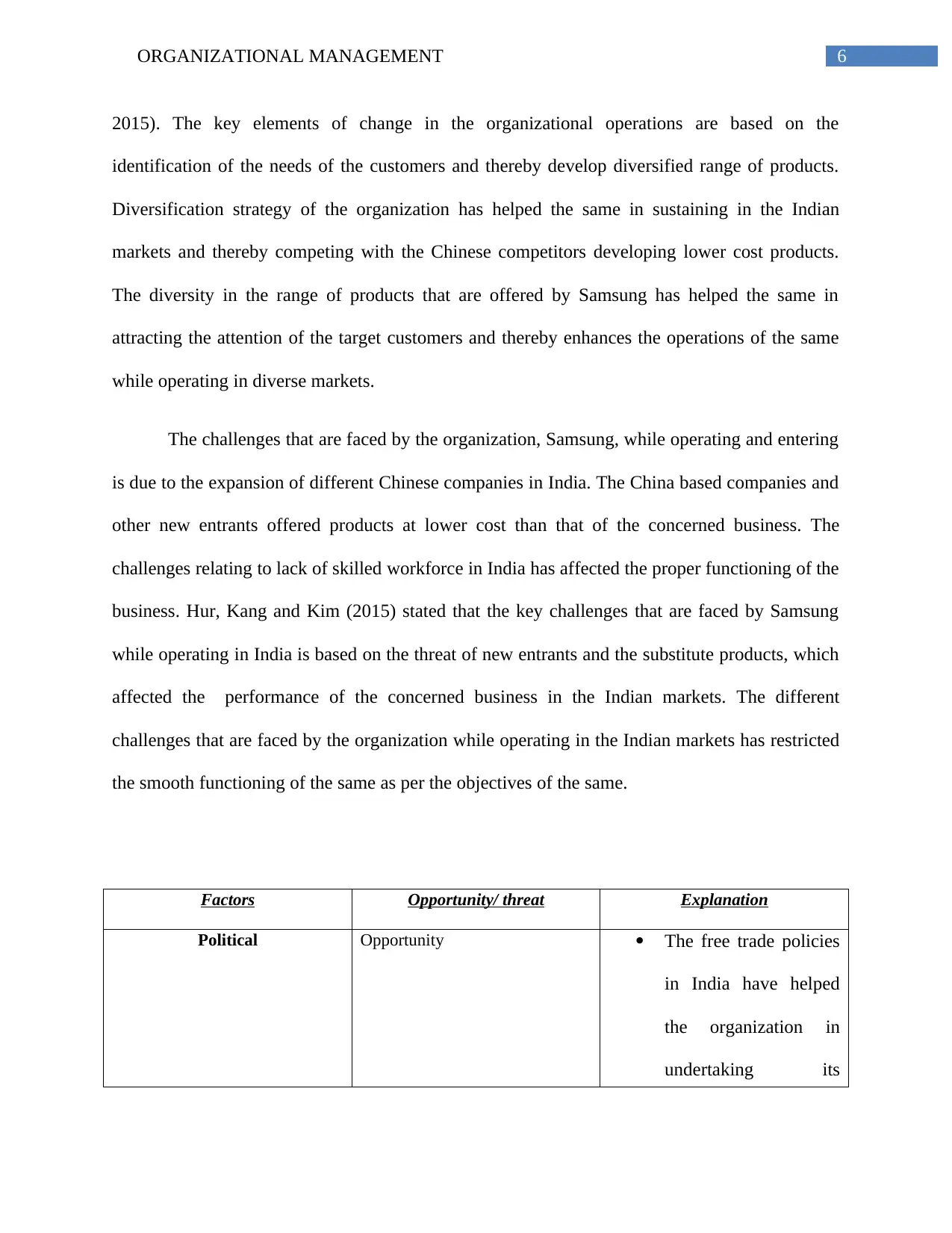
6ORGANIZATIONAL MANAGEMENT
2015). The key elements of change in the organizational operations are based on the
identification of the needs of the customers and thereby develop diversified range of products.
Diversification strategy of the organization has helped the same in sustaining in the Indian
markets and thereby competing with the Chinese competitors developing lower cost products.
The diversity in the range of products that are offered by Samsung has helped the same in
attracting the attention of the target customers and thereby enhances the operations of the same
while operating in diverse markets.
The challenges that are faced by the organization, Samsung, while operating and entering
is due to the expansion of different Chinese companies in India. The China based companies and
other new entrants offered products at lower cost than that of the concerned business. The
challenges relating to lack of skilled workforce in India has affected the proper functioning of the
business. Hur, Kang and Kim (2015) stated that the key challenges that are faced by Samsung
while operating in India is based on the threat of new entrants and the substitute products, which
affected the performance of the concerned business in the Indian markets. The different
challenges that are faced by the organization while operating in the Indian markets has restricted
the smooth functioning of the same as per the objectives of the same.
Factors Opportunity/ threat Explanation
Political Opportunity The free trade policies
in India have helped
the organization in
undertaking its
2015). The key elements of change in the organizational operations are based on the
identification of the needs of the customers and thereby develop diversified range of products.
Diversification strategy of the organization has helped the same in sustaining in the Indian
markets and thereby competing with the Chinese competitors developing lower cost products.
The diversity in the range of products that are offered by Samsung has helped the same in
attracting the attention of the target customers and thereby enhances the operations of the same
while operating in diverse markets.
The challenges that are faced by the organization, Samsung, while operating and entering
is due to the expansion of different Chinese companies in India. The China based companies and
other new entrants offered products at lower cost than that of the concerned business. The
challenges relating to lack of skilled workforce in India has affected the proper functioning of the
business. Hur, Kang and Kim (2015) stated that the key challenges that are faced by Samsung
while operating in India is based on the threat of new entrants and the substitute products, which
affected the performance of the concerned business in the Indian markets. The different
challenges that are faced by the organization while operating in the Indian markets has restricted
the smooth functioning of the same as per the objectives of the same.
Factors Opportunity/ threat Explanation
Political Opportunity The free trade policies
in India have helped
the organization in
undertaking its
Paraphrase This Document
Need a fresh take? Get an instant paraphrase of this document with our AI Paraphraser
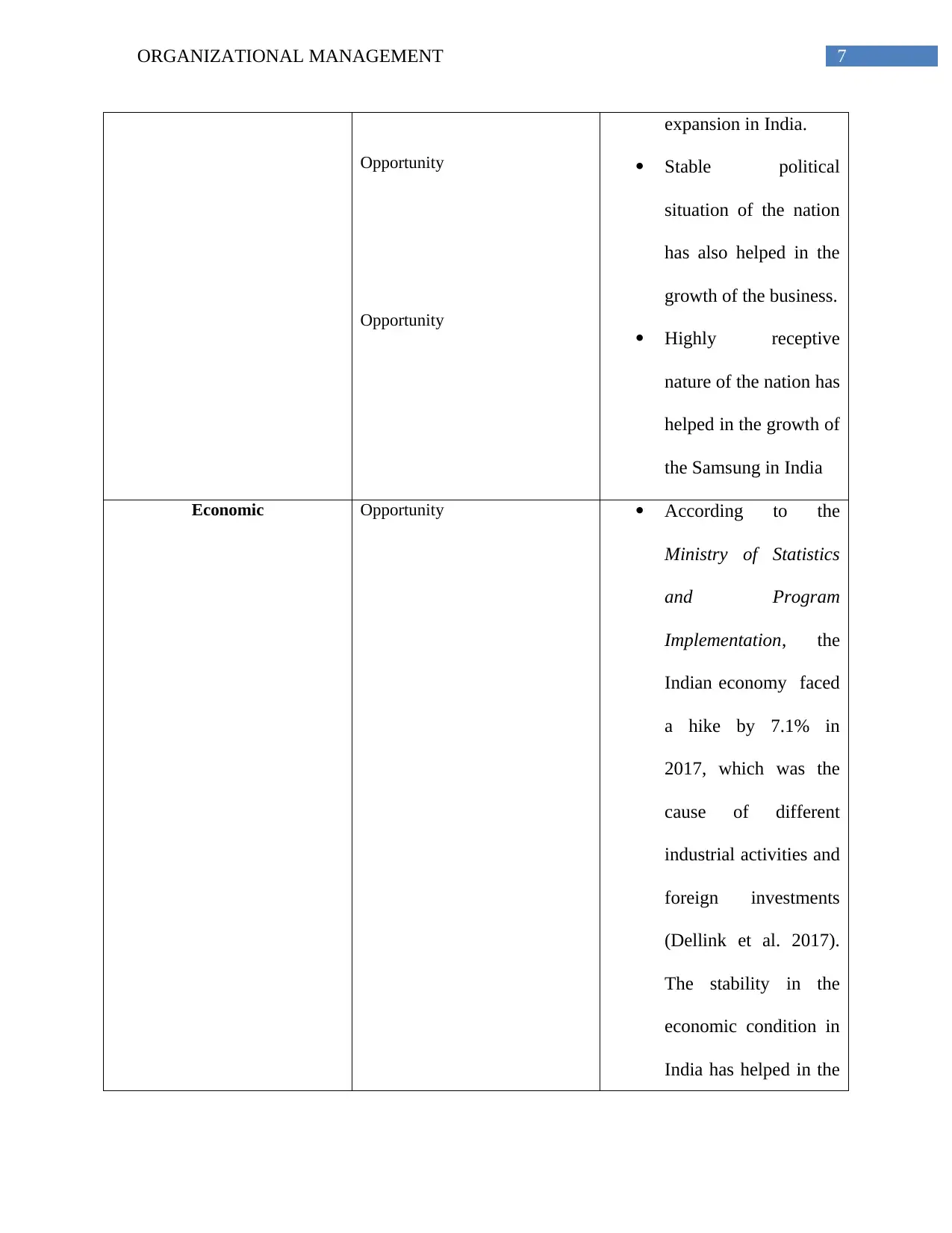
7ORGANIZATIONAL MANAGEMENT
Opportunity
Opportunity
expansion in India.
Stable political
situation of the nation
has also helped in the
growth of the business.
Highly receptive
nature of the nation has
helped in the growth of
the Samsung in India
Economic Opportunity According to the
Ministry of Statistics
and Program
Implementation, the
Indian economy faced
a hike by 7.1% in
2017, which was the
cause of different
industrial activities and
foreign investments
(Dellink et al. 2017).
The stability in the
economic condition in
India has helped in the
Opportunity
Opportunity
expansion in India.
Stable political
situation of the nation
has also helped in the
growth of the business.
Highly receptive
nature of the nation has
helped in the growth of
the Samsung in India
Economic Opportunity According to the
Ministry of Statistics
and Program
Implementation, the
Indian economy faced
a hike by 7.1% in
2017, which was the
cause of different
industrial activities and
foreign investments
(Dellink et al. 2017).
The stability in the
economic condition in
India has helped in the
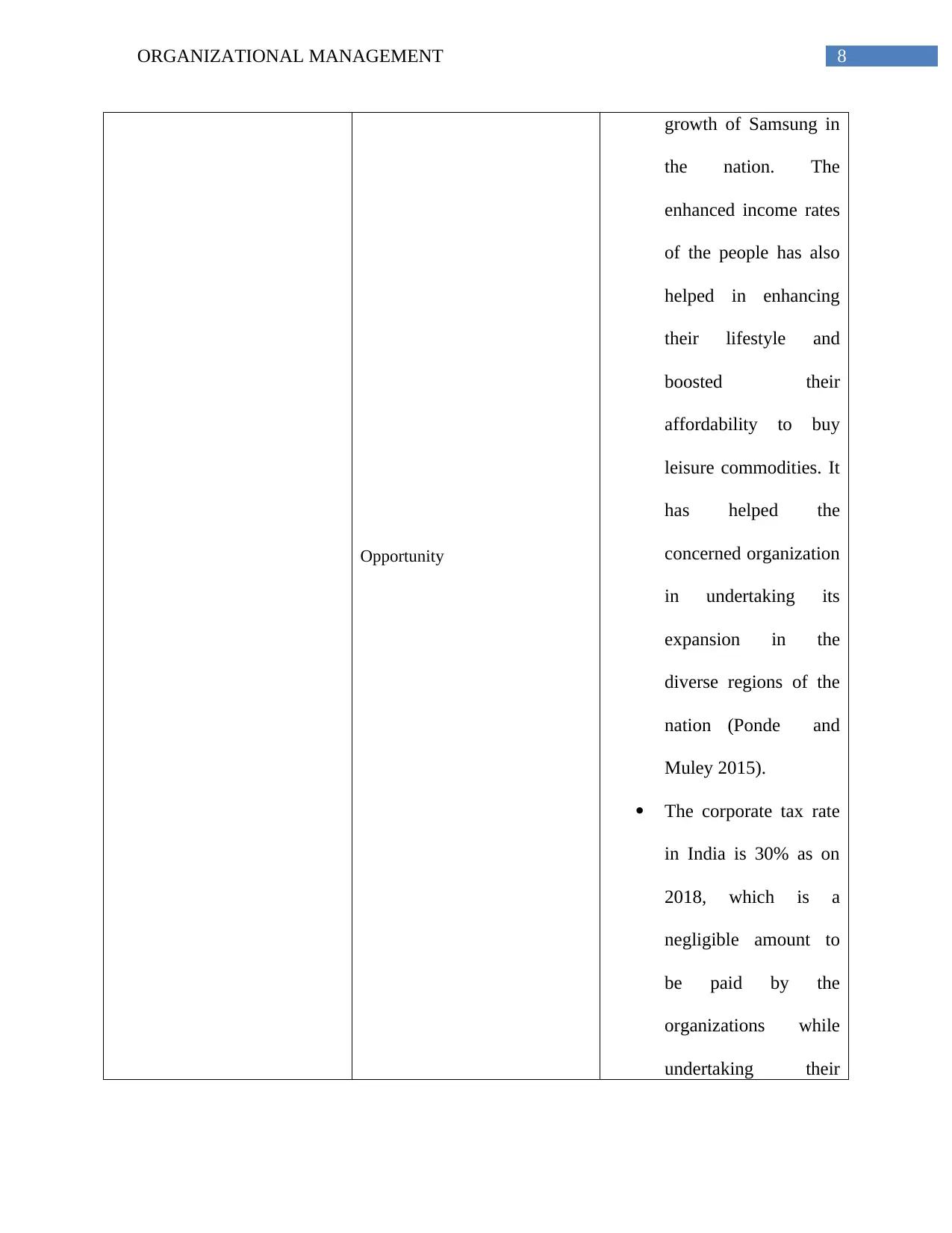
8ORGANIZATIONAL MANAGEMENT
Opportunity
growth of Samsung in
the nation. The
enhanced income rates
of the people has also
helped in enhancing
their lifestyle and
boosted their
affordability to buy
leisure commodities. It
has helped the
concerned organization
in undertaking its
expansion in the
diverse regions of the
nation (Ponde and
Muley 2015).
The corporate tax rate
in India is 30% as on
2018, which is a
negligible amount to
be paid by the
organizations while
undertaking their
Opportunity
growth of Samsung in
the nation. The
enhanced income rates
of the people has also
helped in enhancing
their lifestyle and
boosted their
affordability to buy
leisure commodities. It
has helped the
concerned organization
in undertaking its
expansion in the
diverse regions of the
nation (Ponde and
Muley 2015).
The corporate tax rate
in India is 30% as on
2018, which is a
negligible amount to
be paid by the
organizations while
undertaking their
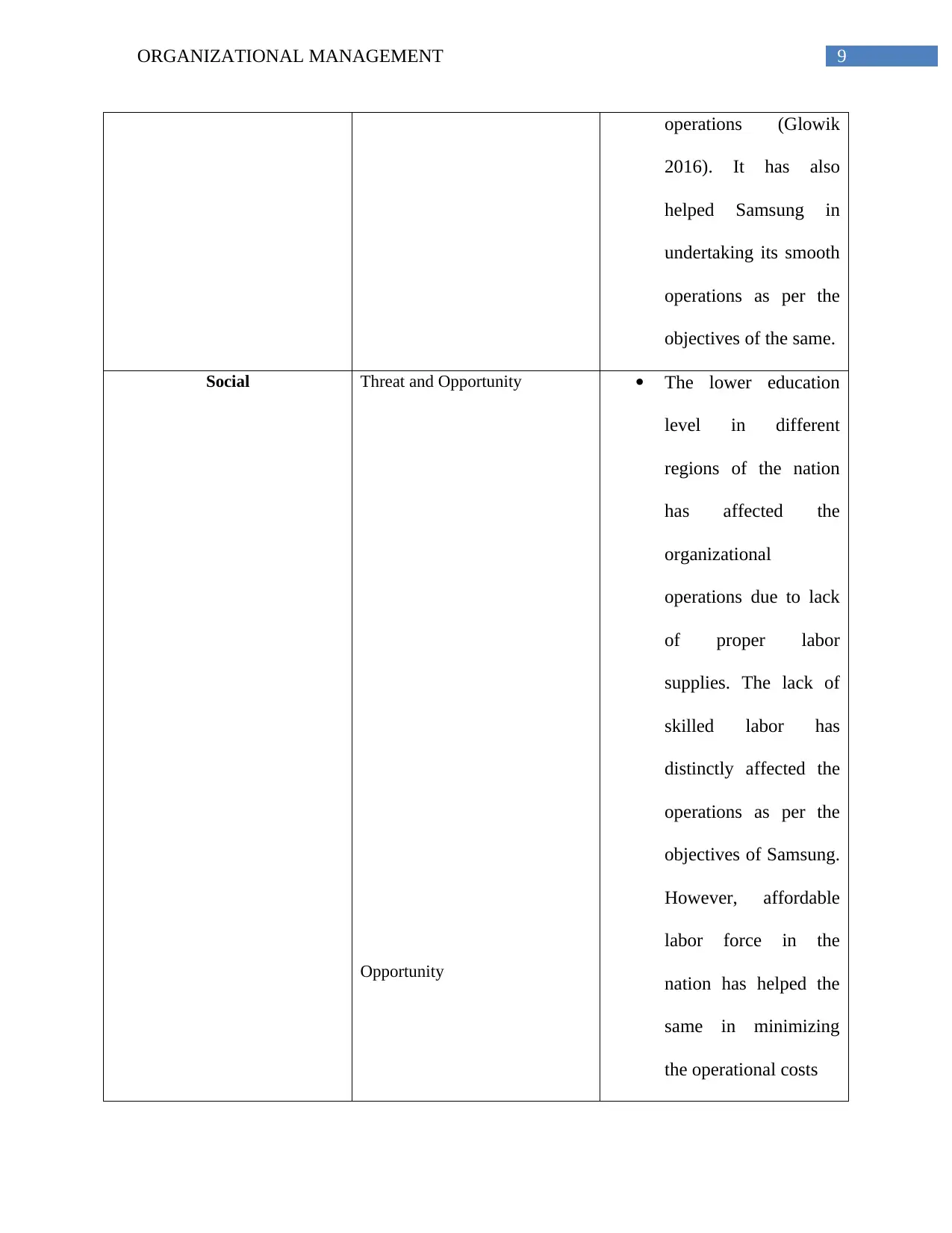
9ORGANIZATIONAL MANAGEMENT
operations (Glowik
2016). It has also
helped Samsung in
undertaking its smooth
operations as per the
objectives of the same.
Social Threat and Opportunity
Opportunity
The lower education
level in different
regions of the nation
has affected the
organizational
operations due to lack
of proper labor
supplies. The lack of
skilled labor has
distinctly affected the
operations as per the
objectives of Samsung.
However, affordable
labor force in the
nation has helped the
same in minimizing
the operational costs
operations (Glowik
2016). It has also
helped Samsung in
undertaking its smooth
operations as per the
objectives of the same.
Social Threat and Opportunity
Opportunity
The lower education
level in different
regions of the nation
has affected the
organizational
operations due to lack
of proper labor
supplies. The lack of
skilled labor has
distinctly affected the
operations as per the
objectives of Samsung.
However, affordable
labor force in the
nation has helped the
same in minimizing
the operational costs
Secure Best Marks with AI Grader
Need help grading? Try our AI Grader for instant feedback on your assignments.
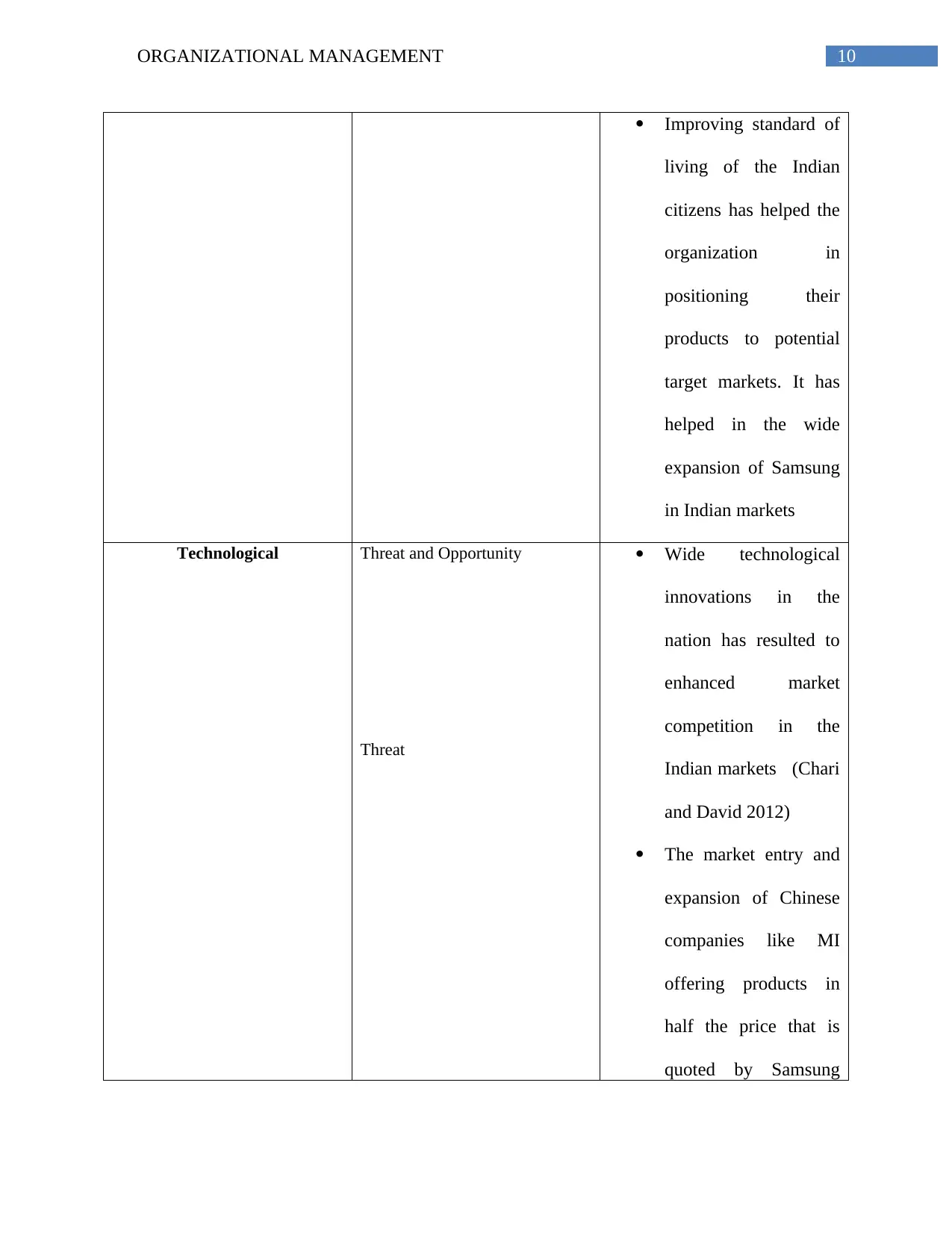
10ORGANIZATIONAL MANAGEMENT
Improving standard of
living of the Indian
citizens has helped the
organization in
positioning their
products to potential
target markets. It has
helped in the wide
expansion of Samsung
in Indian markets
Technological Threat and Opportunity
Threat
Wide technological
innovations in the
nation has resulted to
enhanced market
competition in the
Indian markets (Chari
and David 2012)
The market entry and
expansion of Chinese
companies like MI
offering products in
half the price that is
quoted by Samsung
Improving standard of
living of the Indian
citizens has helped the
organization in
positioning their
products to potential
target markets. It has
helped in the wide
expansion of Samsung
in Indian markets
Technological Threat and Opportunity
Threat
Wide technological
innovations in the
nation has resulted to
enhanced market
competition in the
Indian markets (Chari
and David 2012)
The market entry and
expansion of Chinese
companies like MI
offering products in
half the price that is
quoted by Samsung
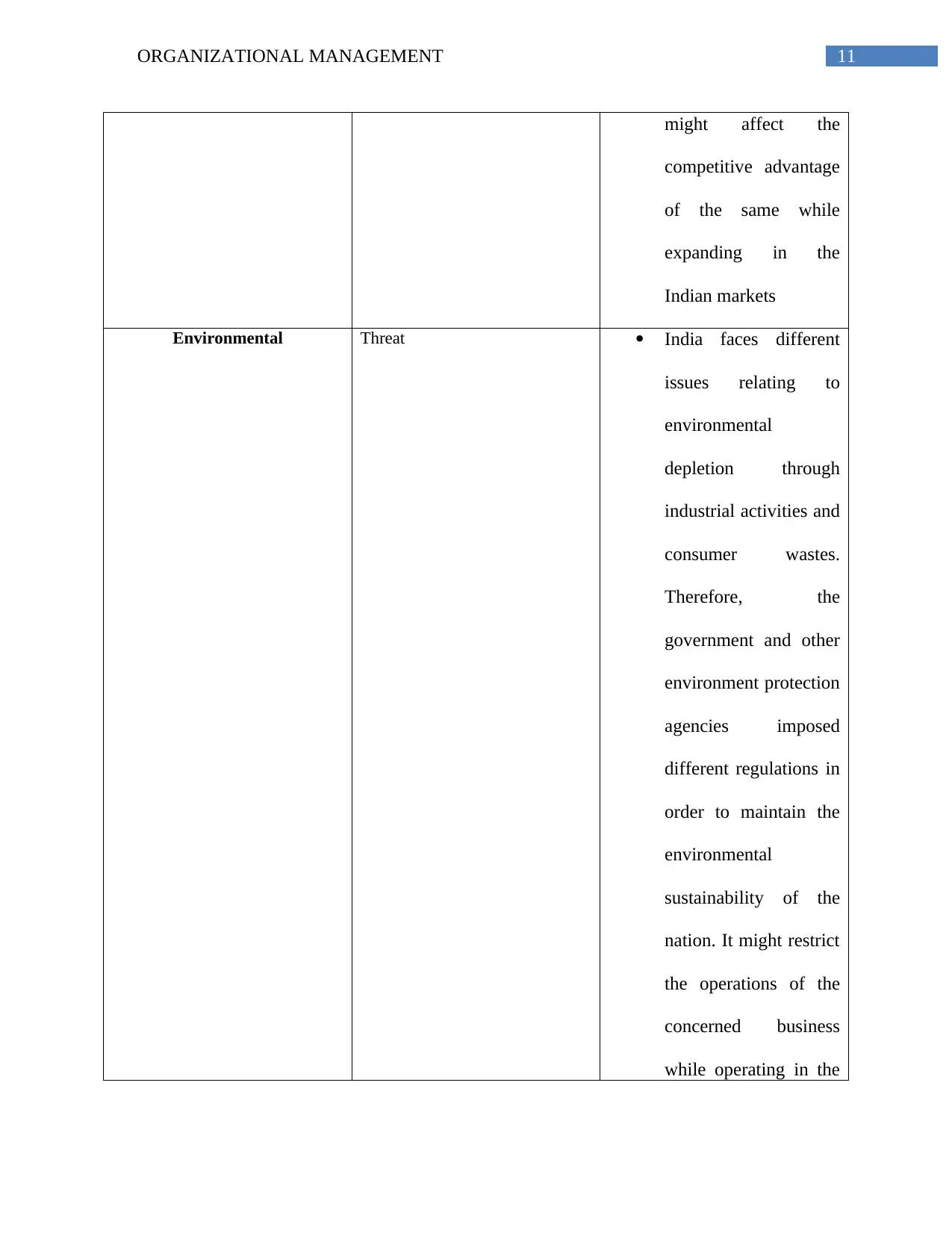
11ORGANIZATIONAL MANAGEMENT
might affect the
competitive advantage
of the same while
expanding in the
Indian markets
Environmental Threat India faces different
issues relating to
environmental
depletion through
industrial activities and
consumer wastes.
Therefore, the
government and other
environment protection
agencies imposed
different regulations in
order to maintain the
environmental
sustainability of the
nation. It might restrict
the operations of the
concerned business
while operating in the
might affect the
competitive advantage
of the same while
expanding in the
Indian markets
Environmental Threat India faces different
issues relating to
environmental
depletion through
industrial activities and
consumer wastes.
Therefore, the
government and other
environment protection
agencies imposed
different regulations in
order to maintain the
environmental
sustainability of the
nation. It might restrict
the operations of the
concerned business
while operating in the
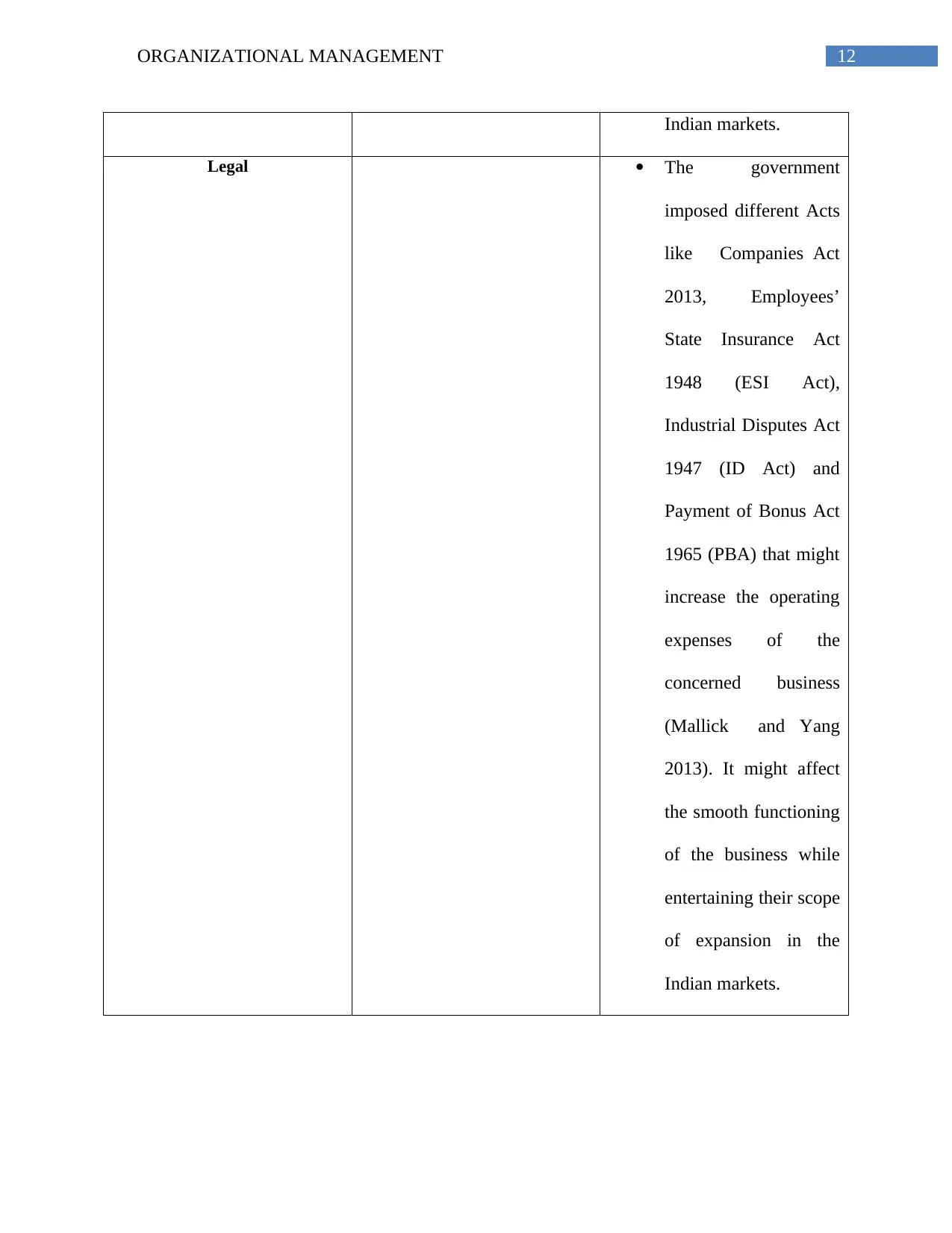
12ORGANIZATIONAL MANAGEMENT
Indian markets.
Legal The government
imposed different Acts
like Companies Act
2013, Employees’
State Insurance Act
1948 (ESI Act),
Industrial Disputes Act
1947 (ID Act) and
Payment of Bonus Act
1965 (PBA) that might
increase the operating
expenses of the
concerned business
(Mallick and Yang
2013). It might affect
the smooth functioning
of the business while
entertaining their scope
of expansion in the
Indian markets.
Indian markets.
Legal The government
imposed different Acts
like Companies Act
2013, Employees’
State Insurance Act
1948 (ESI Act),
Industrial Disputes Act
1947 (ID Act) and
Payment of Bonus Act
1965 (PBA) that might
increase the operating
expenses of the
concerned business
(Mallick and Yang
2013). It might affect
the smooth functioning
of the business while
entertaining their scope
of expansion in the
Indian markets.
Paraphrase This Document
Need a fresh take? Get an instant paraphrase of this document with our AI Paraphraser
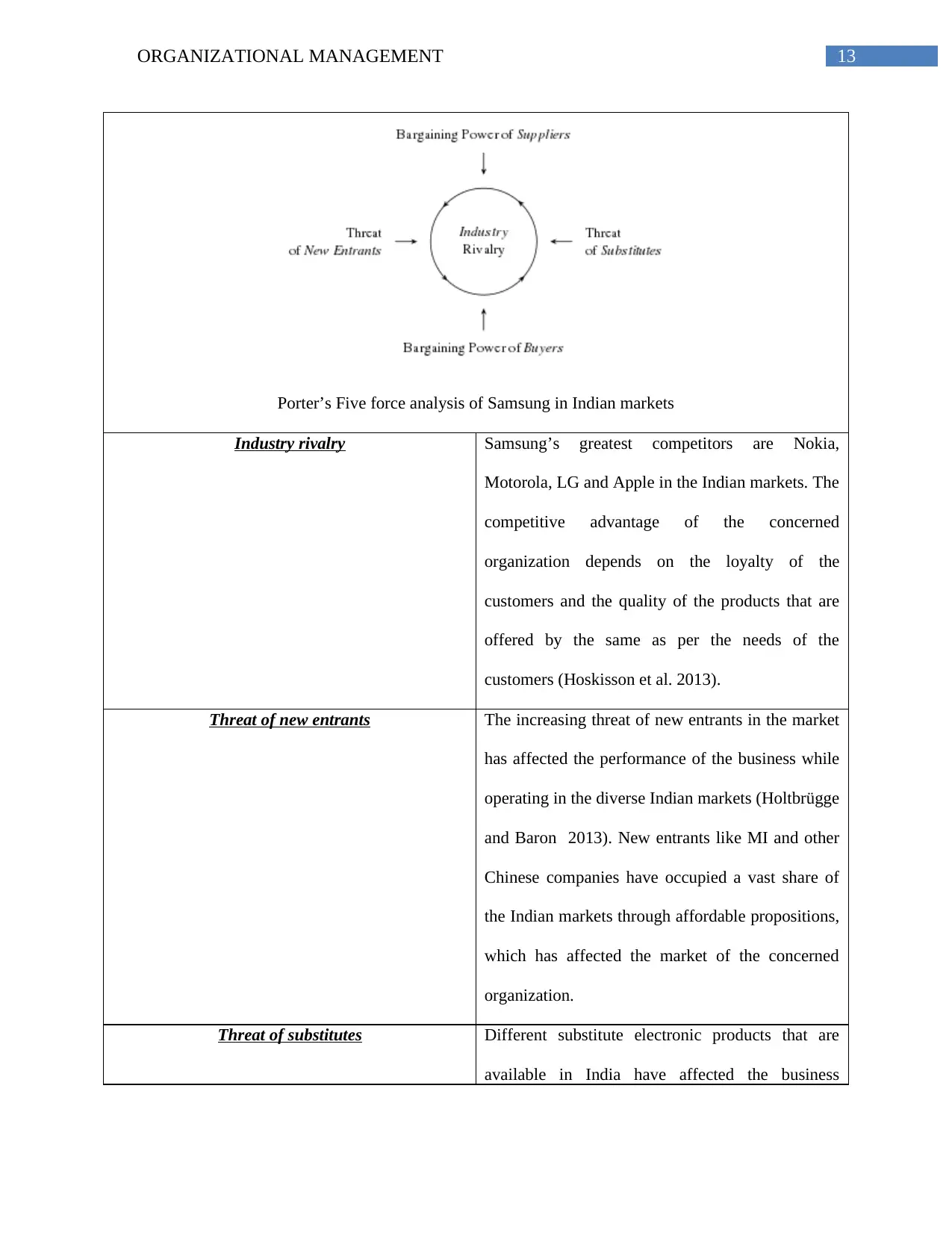
13ORGANIZATIONAL MANAGEMENT
Porter’s Five force analysis of Samsung in Indian markets
Industry rivalry Samsung’s greatest competitors are Nokia,
Motorola, LG and Apple in the Indian markets. The
competitive advantage of the concerned
organization depends on the loyalty of the
customers and the quality of the products that are
offered by the same as per the needs of the
customers (Hoskisson et al. 2013).
Threat of new entrants The increasing threat of new entrants in the market
has affected the performance of the business while
operating in the diverse Indian markets (Holtbrügge
and Baron 2013). New entrants like MI and other
Chinese companies have occupied a vast share of
the Indian markets through affordable propositions,
which has affected the market of the concerned
organization.
Threat of substitutes Different substitute electronic products that are
available in India have affected the business
Porter’s Five force analysis of Samsung in Indian markets
Industry rivalry Samsung’s greatest competitors are Nokia,
Motorola, LG and Apple in the Indian markets. The
competitive advantage of the concerned
organization depends on the loyalty of the
customers and the quality of the products that are
offered by the same as per the needs of the
customers (Hoskisson et al. 2013).
Threat of new entrants The increasing threat of new entrants in the market
has affected the performance of the business while
operating in the diverse Indian markets (Holtbrügge
and Baron 2013). New entrants like MI and other
Chinese companies have occupied a vast share of
the Indian markets through affordable propositions,
which has affected the market of the concerned
organization.
Threat of substitutes Different substitute electronic products that are
available in India have affected the business
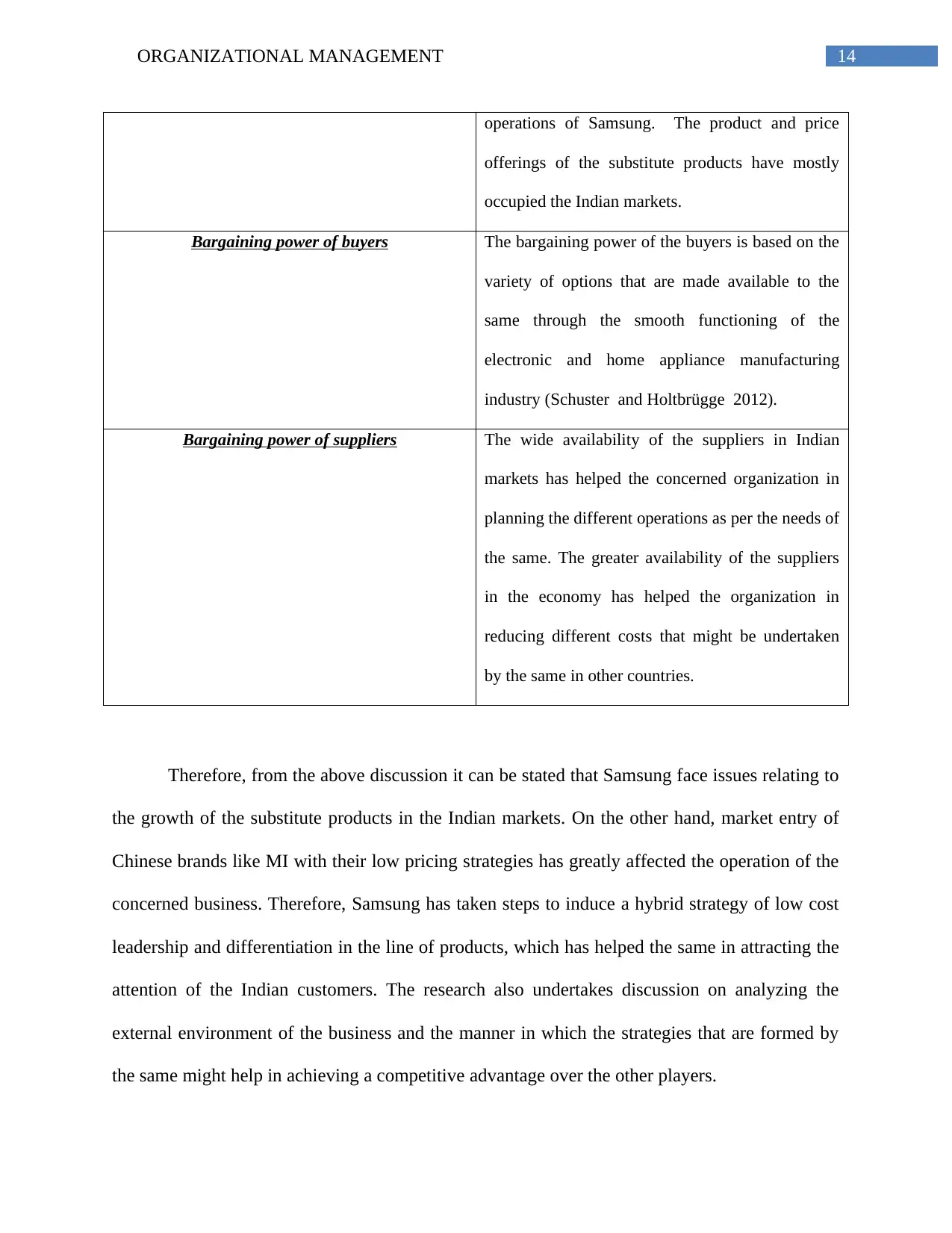
14ORGANIZATIONAL MANAGEMENT
operations of Samsung. The product and price
offerings of the substitute products have mostly
occupied the Indian markets.
Bargaining power of buyers The bargaining power of the buyers is based on the
variety of options that are made available to the
same through the smooth functioning of the
electronic and home appliance manufacturing
industry (Schuster and Holtbrügge 2012).
Bargaining power of suppliers The wide availability of the suppliers in Indian
markets has helped the concerned organization in
planning the different operations as per the needs of
the same. The greater availability of the suppliers
in the economy has helped the organization in
reducing different costs that might be undertaken
by the same in other countries.
Therefore, from the above discussion it can be stated that Samsung face issues relating to
the growth of the substitute products in the Indian markets. On the other hand, market entry of
Chinese brands like MI with their low pricing strategies has greatly affected the operation of the
concerned business. Therefore, Samsung has taken steps to induce a hybrid strategy of low cost
leadership and differentiation in the line of products, which has helped the same in attracting the
attention of the Indian customers. The research also undertakes discussion on analyzing the
external environment of the business and the manner in which the strategies that are formed by
the same might help in achieving a competitive advantage over the other players.
operations of Samsung. The product and price
offerings of the substitute products have mostly
occupied the Indian markets.
Bargaining power of buyers The bargaining power of the buyers is based on the
variety of options that are made available to the
same through the smooth functioning of the
electronic and home appliance manufacturing
industry (Schuster and Holtbrügge 2012).
Bargaining power of suppliers The wide availability of the suppliers in Indian
markets has helped the concerned organization in
planning the different operations as per the needs of
the same. The greater availability of the suppliers
in the economy has helped the organization in
reducing different costs that might be undertaken
by the same in other countries.
Therefore, from the above discussion it can be stated that Samsung face issues relating to
the growth of the substitute products in the Indian markets. On the other hand, market entry of
Chinese brands like MI with their low pricing strategies has greatly affected the operation of the
concerned business. Therefore, Samsung has taken steps to induce a hybrid strategy of low cost
leadership and differentiation in the line of products, which has helped the same in attracting the
attention of the Indian customers. The research also undertakes discussion on analyzing the
external environment of the business and the manner in which the strategies that are formed by
the same might help in achieving a competitive advantage over the other players.

15ORGANIZATIONAL MANAGEMENT
Secure Best Marks with AI Grader
Need help grading? Try our AI Grader for instant feedback on your assignments.
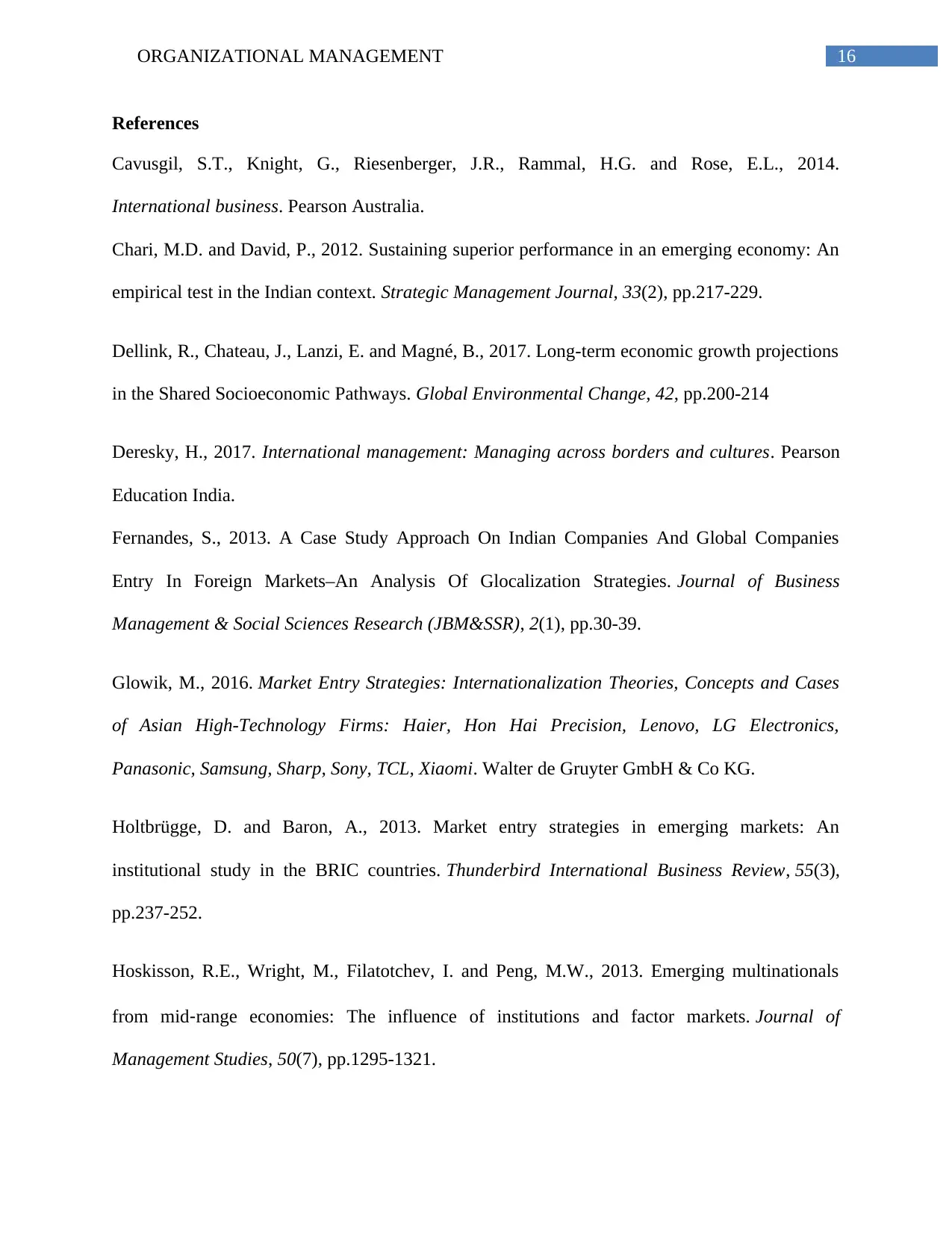
16ORGANIZATIONAL MANAGEMENT
References
Cavusgil, S.T., Knight, G., Riesenberger, J.R., Rammal, H.G. and Rose, E.L., 2014.
International business. Pearson Australia.
Chari, M.D. and David, P., 2012. Sustaining superior performance in an emerging economy: An
empirical test in the Indian context. Strategic Management Journal, 33(2), pp.217-229.
Dellink, R., Chateau, J., Lanzi, E. and Magné, B., 2017. Long-term economic growth projections
in the Shared Socioeconomic Pathways. Global Environmental Change, 42, pp.200-214
Deresky, H., 2017. International management: Managing across borders and cultures. Pearson
Education India.
Fernandes, S., 2013. A Case Study Approach On Indian Companies And Global Companies
Entry In Foreign Markets–An Analysis Of Glocalization Strategies. Journal of Business
Management & Social Sciences Research (JBM&SSR), 2(1), pp.30-39.
Glowik, M., 2016. Market Entry Strategies: Internationalization Theories, Concepts and Cases
of Asian High-Technology Firms: Haier, Hon Hai Precision, Lenovo, LG Electronics,
Panasonic, Samsung, Sharp, Sony, TCL, Xiaomi. Walter de Gruyter GmbH & Co KG.
Holtbrügge, D. and Baron, A., 2013. Market entry strategies in emerging markets: An
institutional study in the BRIC countries. Thunderbird International Business Review, 55(3),
pp.237-252.
Hoskisson, R.E., Wright, M., Filatotchev, I. and Peng, M.W., 2013. Emerging multinationals
from mid‐range economies: The influence of institutions and factor markets. Journal of
Management Studies, 50(7), pp.1295-1321.
References
Cavusgil, S.T., Knight, G., Riesenberger, J.R., Rammal, H.G. and Rose, E.L., 2014.
International business. Pearson Australia.
Chari, M.D. and David, P., 2012. Sustaining superior performance in an emerging economy: An
empirical test in the Indian context. Strategic Management Journal, 33(2), pp.217-229.
Dellink, R., Chateau, J., Lanzi, E. and Magné, B., 2017. Long-term economic growth projections
in the Shared Socioeconomic Pathways. Global Environmental Change, 42, pp.200-214
Deresky, H., 2017. International management: Managing across borders and cultures. Pearson
Education India.
Fernandes, S., 2013. A Case Study Approach On Indian Companies And Global Companies
Entry In Foreign Markets–An Analysis Of Glocalization Strategies. Journal of Business
Management & Social Sciences Research (JBM&SSR), 2(1), pp.30-39.
Glowik, M., 2016. Market Entry Strategies: Internationalization Theories, Concepts and Cases
of Asian High-Technology Firms: Haier, Hon Hai Precision, Lenovo, LG Electronics,
Panasonic, Samsung, Sharp, Sony, TCL, Xiaomi. Walter de Gruyter GmbH & Co KG.
Holtbrügge, D. and Baron, A., 2013. Market entry strategies in emerging markets: An
institutional study in the BRIC countries. Thunderbird International Business Review, 55(3),
pp.237-252.
Hoskisson, R.E., Wright, M., Filatotchev, I. and Peng, M.W., 2013. Emerging multinationals
from mid‐range economies: The influence of institutions and factor markets. Journal of
Management Studies, 50(7), pp.1295-1321.
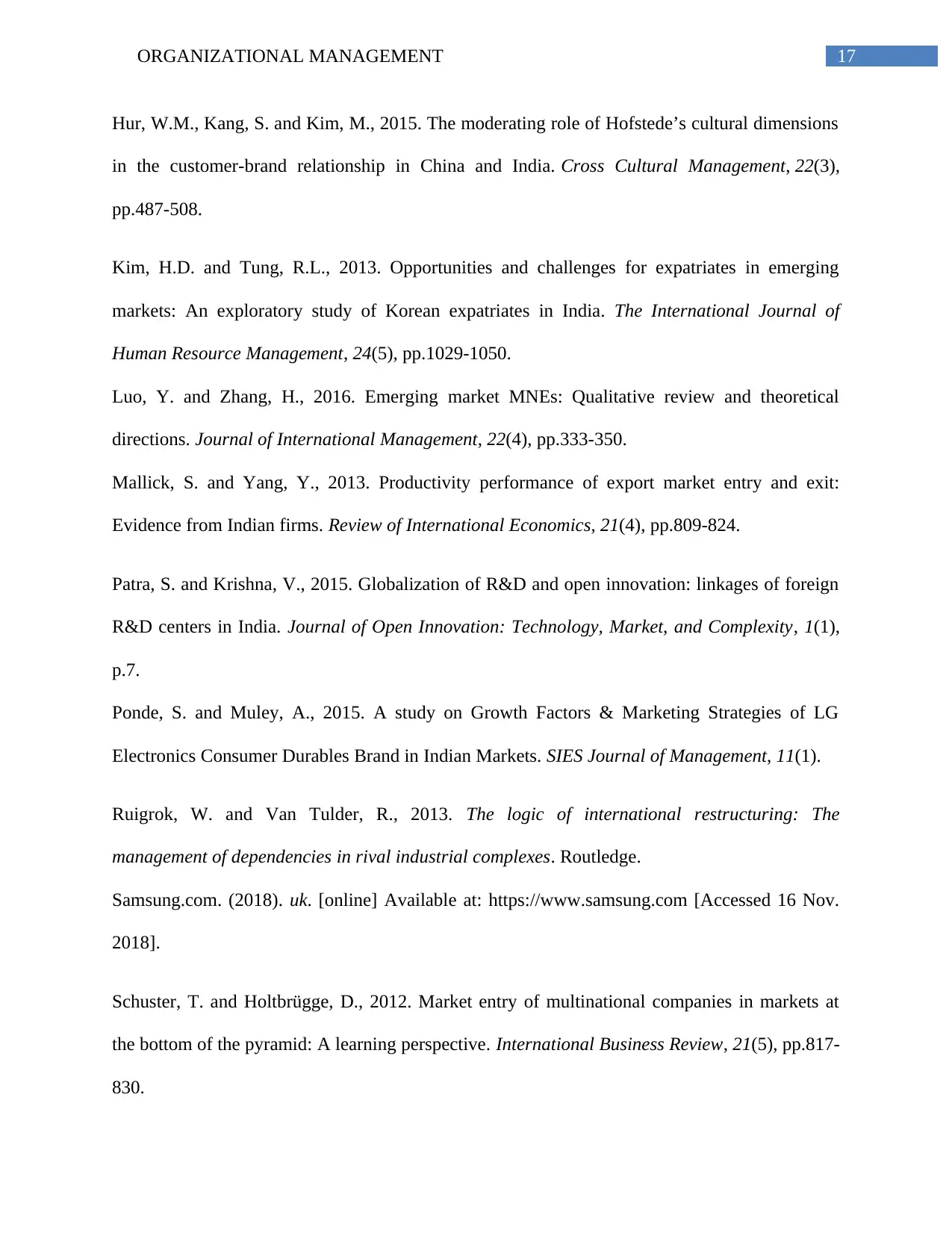
17ORGANIZATIONAL MANAGEMENT
Hur, W.M., Kang, S. and Kim, M., 2015. The moderating role of Hofstede’s cultural dimensions
in the customer-brand relationship in China and India. Cross Cultural Management, 22(3),
pp.487-508.
Kim, H.D. and Tung, R.L., 2013. Opportunities and challenges for expatriates in emerging
markets: An exploratory study of Korean expatriates in India. The International Journal of
Human Resource Management, 24(5), pp.1029-1050.
Luo, Y. and Zhang, H., 2016. Emerging market MNEs: Qualitative review and theoretical
directions. Journal of International Management, 22(4), pp.333-350.
Mallick, S. and Yang, Y., 2013. Productivity performance of export market entry and exit:
Evidence from Indian firms. Review of International Economics, 21(4), pp.809-824.
Patra, S. and Krishna, V., 2015. Globalization of R&D and open innovation: linkages of foreign
R&D centers in India. Journal of Open Innovation: Technology, Market, and Complexity, 1(1),
p.7.
Ponde, S. and Muley, A., 2015. A study on Growth Factors & Marketing Strategies of LG
Electronics Consumer Durables Brand in Indian Markets. SIES Journal of Management, 11(1).
Ruigrok, W. and Van Tulder, R., 2013. The logic of international restructuring: The
management of dependencies in rival industrial complexes. Routledge.
Samsung.com. (2018). uk. [online] Available at: https://www.samsung.com [Accessed 16 Nov.
2018].
Schuster, T. and Holtbrügge, D., 2012. Market entry of multinational companies in markets at
the bottom of the pyramid: A learning perspective. International Business Review, 21(5), pp.817-
830.
Hur, W.M., Kang, S. and Kim, M., 2015. The moderating role of Hofstede’s cultural dimensions
in the customer-brand relationship in China and India. Cross Cultural Management, 22(3),
pp.487-508.
Kim, H.D. and Tung, R.L., 2013. Opportunities and challenges for expatriates in emerging
markets: An exploratory study of Korean expatriates in India. The International Journal of
Human Resource Management, 24(5), pp.1029-1050.
Luo, Y. and Zhang, H., 2016. Emerging market MNEs: Qualitative review and theoretical
directions. Journal of International Management, 22(4), pp.333-350.
Mallick, S. and Yang, Y., 2013. Productivity performance of export market entry and exit:
Evidence from Indian firms. Review of International Economics, 21(4), pp.809-824.
Patra, S. and Krishna, V., 2015. Globalization of R&D and open innovation: linkages of foreign
R&D centers in India. Journal of Open Innovation: Technology, Market, and Complexity, 1(1),
p.7.
Ponde, S. and Muley, A., 2015. A study on Growth Factors & Marketing Strategies of LG
Electronics Consumer Durables Brand in Indian Markets. SIES Journal of Management, 11(1).
Ruigrok, W. and Van Tulder, R., 2013. The logic of international restructuring: The
management of dependencies in rival industrial complexes. Routledge.
Samsung.com. (2018). uk. [online] Available at: https://www.samsung.com [Accessed 16 Nov.
2018].
Schuster, T. and Holtbrügge, D., 2012. Market entry of multinational companies in markets at
the bottom of the pyramid: A learning perspective. International Business Review, 21(5), pp.817-
830.
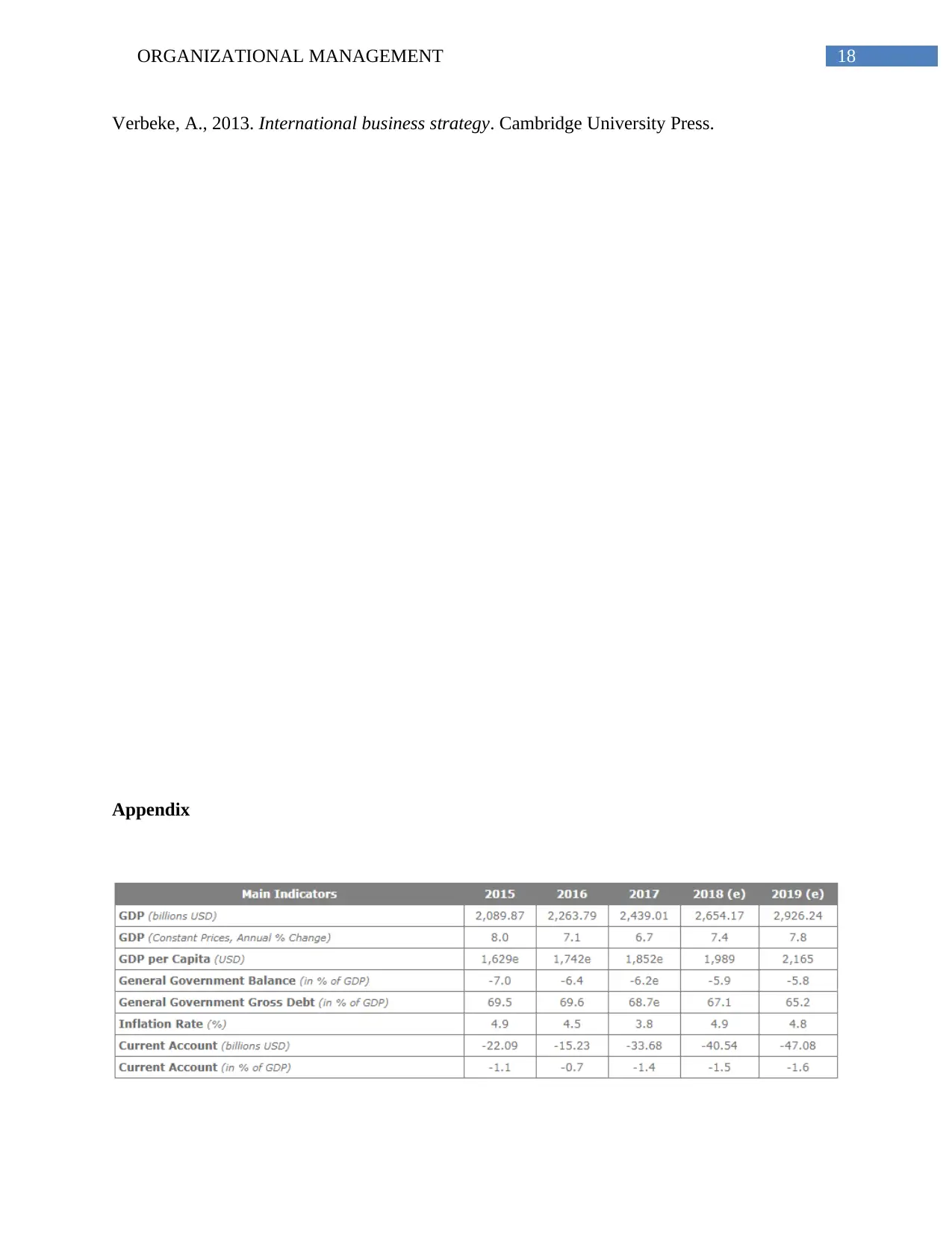
18ORGANIZATIONAL MANAGEMENT
Verbeke, A., 2013. International business strategy. Cambridge University Press.
Appendix
Verbeke, A., 2013. International business strategy. Cambridge University Press.
Appendix
Paraphrase This Document
Need a fresh take? Get an instant paraphrase of this document with our AI Paraphraser

19ORGANIZATIONAL MANAGEMENT
Figure: The economic situation of India
(Source: Dellink et al. 2017)
Figure: The economic situation of India
(Source: Dellink et al. 2017)
1 out of 20
Related Documents
Your All-in-One AI-Powered Toolkit for Academic Success.
+13062052269
info@desklib.com
Available 24*7 on WhatsApp / Email
![[object Object]](/_next/static/media/star-bottom.7253800d.svg)
Unlock your academic potential
© 2024 | Zucol Services PVT LTD | All rights reserved.





